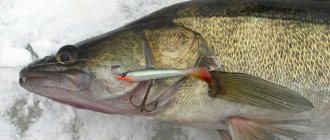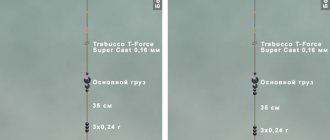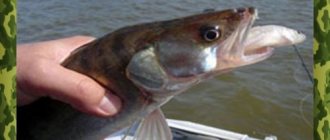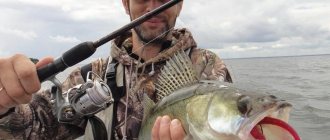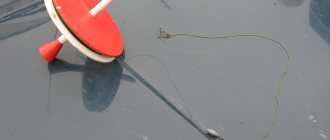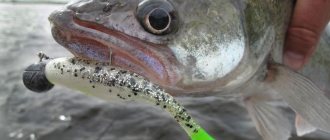Choosing a fishing spot
In June, pike perch begins to switch to summer mode. He is no longer particularly hungry, so he does not strive to eat everything that moves, as in the spring. Unlike the spring period, at the beginning of summer you can switch to shallow fishing, where small fish are found.
It is recommended to take soft baits with small weights and a spinner as bait. At depth, standard weighted baits are used. The best time for hunting is evening or night. A place for catching pike perch in June is chosen during the day, and special attention should be paid to fresh and clean water, because pike perch avoids polluted water bodies.
Catching pike perch in summer with a spinning jig
Jig fishing for pike perch in the summer, regardless of June, July, August, has its own established unspoken rules, as well as many exceptions both in terms of wiring and the size and type of bait.
Unspoken rules have been established, this is a classic wiring, two turns - a pause. Fishing the edges is like dragging bait on a stepped retrieve from the shallows to the depths. The opposite option is the same: anchor the boat on the shallows, throw the jig rig into the depths, and use a stepped retrieve to drag the bait up the edge. The baits are generally 3-4 inches in size. it can be either silicone (twister, vibrotail, slug, crayfish), or foam rubber, mandula. It’s impossible to give a specific recommendation here, different bodies of water, different presentation of bait by the spinning rod. Here, only by sampling is it possible to determine what the fish are biting at at a given time in a given body of water.
And also the second option, an exception to accepted norms. And this is fishing for pike perch in the summer with very small baits, or vice versa, fishing with large, 5 or more inches of bait. It’s the same with spinning retrieves, instead of the classic retrieve, two turns and a pause, we drag the bait along the bottom, or put light weights so that the bait hangs above the bottom longer. This is where the skill of the spinner comes into play. In addition, pressure from other spinning anglers necessarily pushes the angler to constantly experiment with baits and baits.
A spinning rod for catching pike perch in the summer with a jig must have the necessary requirements. Namely, a fairly sensitive tip, or a ringing form, that informs the spinner when the bait touches the bottom, or another bottom obstacle, and also informs about a bite, “knock” on the hand, or flinching of the tip. And the second, equally important aspect of a spinning rod for catching pike perch with a jig is its ability to cut through the bony mouth of a fish. It should have a so-called “ridge”, which falls on the middle part of the form. If the spinning rod is softer, even if according to the test it is extra-fast, it will not penetrate the pike perch poorly. This is clearly noticeable when we pull the pike perch towards the boat, and then it opens its mouth, shakes its head and the bait flies out of its fanged mouth. It’s just that the spinning rod was not strong enough to catch pike perch. We will not recommend specific models here. It’s better to leave positive reviews about your spinning rods for catching pike perch in the comments.
Features of fishing techniques
You should catch pike perch in June using mugs, wobblers, and spinning rods.
Spinning fishing technique
When choosing a spinning rod, you need to pay attention to the fact that the fish will bite better on soft foam fish or jig baits. The more actively the bait moves in the water, the more interest it will be for pike perch.
We also recommend reading:
Roach in June 2021: rules and features of fishing Fishing for crucian carp in June 2021: an unpredictable activity Catching perch in June 2021: an exciting and challenging activity Catching bream in June 2021: rules, tips, nuances
Jig baits perform especially well if the pike perch lies on the bottom. To catch large fish, you can try using twisters or jigs. The use of silicone worms and fish gives good results. When using worms, you should give preference to a lightweight rod and reel slowly. At the same time, it is important to make stops so that the pike perch has time to approach the bait. The best colors for bait are gray, lemon, pearlescent, green.
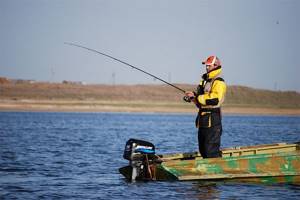
Wobbler fishing technique
It’s difficult to catch pike perch using a wobbler, but it’s possible. The wobbler should be used in wide rivers, using slow horizontal wiring.
It is better to choose a surface bait, slightly submerged in the water. Spoons are not used for pike perch in summer.
Choosing a fishing method
It is allowed to begin fishing for pike perch in June after spawning. The most common and one of the simplest methods of catching pike perch is with a spinning rod using bait. Let's take a closer look at this method using various attachments:
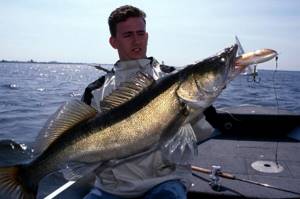
Fishing with live bait using a sliding sinker. It has been noticed that pike perch has the habit of attacking at the moment when the prey rises from the bottom, heading upward. If the predator feels resistance, it immediately moves away. The use of a sliding sinker in this fishing method eliminates the possibility of drag on the bait.- Fishing using a rotating spoon that imitates the movements of small fish. It is noted that the best in this matter is a wobbler, the color of which is selected according to the transparency of the water. The color should be brighter the lower the water transparency.
- Catching pike perch on a bottom fishing rod using live bait - gudgeon, gobies, bleak.
For spinning
When going fishing for pike perch, get a high-rigidity spinning rod with an inertial reel. Buy a set of baits in the form of plastic or foam rubber narrow fish, spoons, vibrating tails, wobblers.
You can fish with a spinning rod both from the shore and from a boat. In order not to scare the fish, you should cast the bait carefully, from afar, moving away from the shore. The best weather when catching this predator is cloudy or rainy. In such weather, pike perch loses their vigilance and is not so careful.
The most successful fishing is with a spinning rod in the shallows, where small fish swim and are preyed on by pike perch. In this case, a wobbler or spinner is used as bait. The wiring should not be done abruptly, it should be soft and smooth.
Proper placement of the bait is the main success of spinning fishing.
What types of wiring are there:
- stepped - when casting the bait, we wait for it to touch the bottom, make several turns with the reel, and again wait for the bait to fall to the bottom;
- uniform wiring - reel in the fishing line at the same speed;
- for drift - we throw the bait and wait for it to be carried away by the current, without reeling in the reel;
- bottom wiring - a weight located in front of the bait muddies the water, dragging it along the bottom. Effective for fishing from a boat.
The best time to catch pike perch is in June before dawn or from late sunset until dark.
For mugs
By mid-June, the fish, having had their fill after spawning, especially the females, lie at depth in holes and rest there. A place for the circles is chosen without a current, near the edge with differences in depth. 150 meters from the edge they set the mugs at anchor and wait for bites. After about 30 minutes, the location of the circles changes until a bite appears. This is how they look for the location of females; 3-4 permutations are usually enough to determine their rookery.
Important: July pike perch usually bites in holes in the morning, from about 9 to 10, at which time it is possible to catch large specimens.
To catch saturated fish that have settled in holes, they use the method of fishing with mugs using live bait. Mugs are made from soft wood or foam, the bottom of which is painted white with longitudinal dark stripes, and the top is painted red. The bright color makes the bite movements noticeable even on a small wave.
For baits, live fish measuring from 5 to 7 centimeters are used. With the help of circles you can catch a large pike perch sitting in a hole.
You need to do the following:
- Circles with live bait are placed at anchor around the hole, as if bringing the bait under the nose of the fish. In this situation, even the laziest predator will not miss the opportunity to grab prey.
- The location of the circles is changed after two to three days, if there are no bites, moving towards the shallows.
- In small areas, gear is installed in advance at night. And at dawn they check for bites.
- During the bleak spawning period, mugs can be placed 20 - 30 meters from the shore, because the main food of pike perch is tasty fish, which the predator hunts for. Moreover, the deeper the live bait is lowered, the larger the pike perch caught on it
How to catch a large specimen
The activity of pike perch in June decreases, so you will have to try hard to get a good catch. The best option is to use circles near the pits. Despite the fact that pike perch is passive in the summer, bait scurrying right in front of its nose will make it perk up and attack.
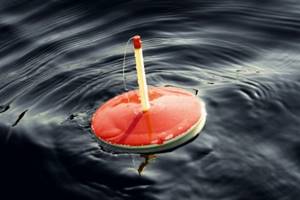
For a rich catch, it is important to choose the right hole. The ideal option is an edge with a sharp difference in depth. You should retreat about 200 meters from it and find a place with a rocky bottom and no current. This is where the circles are placed. Then you need to wait 30 minutes and see if there is a bite. If it is not there, it is recommended to move to a new place.
Another method that can work is early fishing. In June, pike perch is interested in food only in the morning - from 9 to 10 o'clock. Therefore, it is not advisable to place mugs in the evening and at night.
From 2 a.m. the fish move to shallow edges. At 5 a.m. she smoothly moves to the deep edge, where she sits until 10 a.m. During the day, the flock migrates, and in the evening again moves to the deep edge.
Pike perch in June, features of fish behavior
In the June days, pike perch individuals have already freed themselves from the spawning process, but they still have some concerns about their offspring. But signs of gluttony are already actively appearing, although not yet so active. Groups of females can be located at great depths, trying to rest a little after the spawning process, and only occasionally, when they are too hungry, do they go out to catch prey.
In this case, if you know the exact location of the pits in which such beds of female pike perch may be located, then it is advisable to place mugs in such places. Thus, the bait will be located right under the fish’s nose, and it will certainly try to attack this prey. If you fish in such holes with a rod, then a more promising bite will be observed in the mornings.
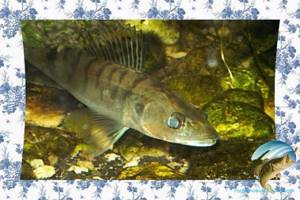
The last ten days of June is the time of active weight gain for this fish. All individuals have already completely rested from the spawning process, and therefore show increased activity in their hunting. Therefore, there are processes of active migration of this fish throughout the reservoir.
Closer to night time, this fish tries to carry out its hunting processes in shallow water areas, but at the same time away from the coastline. As soon as dawn breaks, the fish again move to greater depths.
What is the best bait to fish with?
Since pike perches are part of the perch family, the baits used to catch this fish are almost the same. Being a predator, this fish always prefers natural bait.
These baits can be all kinds of smaller fish - you can use freshly caught bleaks, small crucian carp or minnows; pike perch loves small roach. In addition, you can use parts of crayfish or frogs, especially at night.
If you choose from a wide range of artificial baits, the most suitable are the following:
- - pike perch are very fond of baits that quite accurately copy real fish, made of silicone types of material;
- — in addition, you can use baits made of foam rubber materials;
- — all kinds of wobblers are used;
- — many fishermen use spinner spoons to catch this fish.

Predatory instincts force pike perch to attack almost any moving target. At different times of the day, in different bodies of water, depending on weather factors, the taste preferences of a given fish can change greatly, therefore it is necessary to use more frequent changes of bait when fishing for pike perch.
You can use pieces of fresh meat for bait, which are strung on hooks and cast. The smell of meat quickly spreads through the water, attracting predators. Your catch is guaranteed. But it should be borne in mind that other types of predatory fish also bite well on all this bait.
Choosing a rod and equipment
To catch pike perch in the summer season, you should carefully select equipment so as not to miss large fish.
- Rod . For pike perch fishing, a distinctive feature of the rod is its rigidity. This is necessary to be able to cast heavy baits and make sharp hooks. long with fast and ultra-fast action are suitable . A more noticeable bite will be provided by a rod with a soft top - quivertip . test should cover 10% of the mass of the bait. The optimal option is 30-35 grams, which makes it possible to level out sharpness when casting into the distance. With a test of 60-70 grams, the spinning rod will not allow you to work out a large proportion of weak bites.
- Fishing line . Use monofilament with a diameter of 0.22-0.35 mm or a braided cord with a breaking load of at least 5 kg. Some fishermen prefer to equip their rod with a fluorocarbon leader, which is highly durable and wear-resistant.
- Reel _ Inertial and inertialess reels are suitable for summer fishing; their size is larger than average. The former are used quite rarely; more and more experienced fishermen prefer “meat grinders”.
- Hooks . Single ones are used, of increased strength and very sharp, capable of holding a large individual that has not lost any activity after hooking.
There are many ways to increase your fish catch, but the most effective ones are. Below, the site editors share with you the 3 most effective ways to increase your catch:
- Bite activator. This is a pheromone-based additive that activates receptors in fish. ATTENTION! Rybnadzor wants to ban this bait!
- Any other baits with flavorings are less effective; it is better if they contain pheromones. But the most effective way is to use the new product of 2016 - DYNAMITE EFFECT!
- Learning different fishing techniques. For example, it is written here about spinning wires.
A little about the predator
The zander is considered a predator. It has a narrow mouth and therefore hunts mainly on fish with an elongated body configuration. To capture and hold prey, pike perch have a number of razor-sharp teeth on their upper and lower jaws.
Pike perch lives in bodies of water with a high oxygen content, such as rivers and large lakes, and is also found in the seas. Small pike perch stay in schools and very often change their location during morning or evening fishing.
They live mainly in flooded bushes and trees near a rocky or sandy bottom. Large pike perch walk alone and can be found anywhere in the reservoir.


